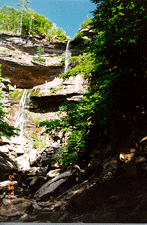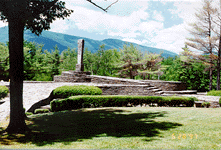

NEW YORK
It is ironic that New York is more popularly associated with the crowded canyons of Manhattan rather than the beautiful natural areas of a state that is amazingly rich in its cultural and historical heritage. Outside the main cities, much of the countryside is comprised of farmlands and forests. The New York State Park system is the oldest in the nation and protects the state's woodlands in hundreds of parks from Montauk Point, a 724 acre park at the tip of Long Island to the massive 6 million acre Adirondack Park, the largest American park outside of Alaska. It encompasses approximately 25 percent of the entire state with about 100,000 acres of old growth forests that existed when Europeans first began to settle in America. The giant trees of these forests were purposely nurtured by native peoples who developed a unique Woodland culture.

Paleo-hunters swept across the Bering Strait and arrived in the region about 11,000 years ago. They were a nomadic people who traveled in small groups that were dependent upon migratory game animals. They favored the large, fertile valleys and coastal plains where their descendants settled into a semi nomadic lifestyle of hunting, fishing and gathering wild vegetable foods around 4,000 BC to 1500 BC. Stretching from the Atlantic coastline in the south to the shores of Lakes Erie and Ontario in the west, thousands of lakes and extensive river systems lay within the state's boundaries. These exceptionally well watered areas with fertile soil allowed the evolution of the Woodland tribes of the region who greeted the early explorers. They developed permanent, agricultural communities that cultivated crops of corn, beans, squash and pumpkins. As populations grew, they adopted more sophisticated social and religious systems. Culture and trade developed along with pottery and basketry skills that were needed for the storage and transportation of their produce. The great rivers, lakes and ocean were the sources of an abundance of fish while the nearby forests sheltered game animals and provided wood to construct their homes, canoes and an assortment of hunting and domestic tools. The numerous Woodland tribes of New York State belonged to three main language groups: the Iroquoian, Algonquian and Siouan languages. Algonquian speaking people dominated the area until about the 14th century when Iroquoian tribes began to move south from the region between Lake Champlain and the St. Lawrence River. Intertribal warfare was common even among tribes sharing the same language group because tribes were based on kinship and locality rather than a common ethnicity.

Like Columbus, many of the early explorers of North America were looking for a western route to the Orient. Giovanni Cabotto's (John Cabot) journey on behalf of the English in 1497 is the first documented meeting of Europeans and the Northeastern Woodland tribes. Giovanni da Verrazano explored the coastline from North Carolina to Nova Scotia entering New York Bay in 1524. By 1527, the Basques had established a whaling station in Labrador and European boats regularly fished in North American coastal waters. When the French explorer, Jacques Cartier arrived in the Gulf of St. Lawrence in 1534, Mi'kmaq paddled out in their canoes waving their beaver skins indicating that they were accustomed to trading with Europeans.
For years, the French dominated the American fur trade in Europe with the help of their Algonquin allies although they were not adverse to dealing with other tribes whenever there was an opportunity. Native groups competed to deal with the French because they prized the European weapons that provided an advantage in their wars with each other. In 1609, Samuel de Champlain established a French trading post at Montreal and explored northern New York while Henry Hudson sailed along America's Atlantic coastline in search of a northwest passage to the Orient for the Dutch. He thought that he may have been successful as he entered the wide mouth of the Hudson River but was disappointed when the river narrowed. Nevertheless, Hudson followed his namesake to the shallow waters near Albany. Enthused by the prospect of a lucrative fur trade, Dutch merchants sent ships down the Hudson the following year. The rapid increase in European demand for beaver skins created great rivalries in Europe and in North America resulting in the formation of many alliances and two centuries of ongoing wars.
The date of the founding of the League of Houdenosaunee or Five Nations is uncertain. Some think that the Iroquois tribes of the Senecas, Cayugas, Onondagas, Oneidas and Mohawks settled their differences around 1570 in response to the increasing pressure of the Algonquins who possessed a greater advantage in European weaponry. Besides being fierce warriors, the Iroquois were politically astute and welcomed the Dutch traders who appeared on the Hudson River in 1610. Their alliance with the Dutch provided them with the weapons they desired and their military superiority propelled them to prominence as the most important native group in New York and in all of North America.
Although the fur trade was profitable for the Dutch, they were not particularly impressed with New Netherland. During their 50 year occupation, they were more concerned with their wealthy Caribbean colonies and their attempts to seize Brazil from the Portuguese. At first, only the fur traders arrived. Later, in 1621, the charter of the Dutch West India Company established a monopoly on the fur trade and subsidized the settlement of 30 Walloon families in 1624. Dutch immigration to New Netherland was slow compared to other North American colonies because they were a wealthy people and few wanted to leave the comfort of their homes for the dangers of living among warring tribes. The prospect of emigrating was made even less attractive with the imposition of a feudal system of patroonships as well as bans on weaving and participation in the fur trade. Their alliance with the Iroquois whose territories spanned Northern New York effectively kept the French at bay but they were powerless to stop the Swedes from settling at the mouth of the Delaware River or to prevent the New England colonists from pressing south to occupy the Connecticut valley and the shores of Long Island. Resenting the wedge between the New England and the southern colonies, the English refused to recognize the Dutch claim to New Netherland and in 1664, King Charles II gave his brother, the Duke of York, all the land between the Hudson and Connecticut Rivers. The Duke sent a large fleet to demand his lands that were surrendered without a fight and New Netherland became New York.
The arrival of the English in New York marked the beginning of the hundred year struggle between the English and French for control of North America. The British quickly formed an alliance with the Iroquois that served to protect them from the French. Meanwhile, the French formally claimed New France in 1665 because they were concerned that the British would try to gain control of the fur trade. The subsequent brunt of French aggression was borne mainly by the Mohawk Iroquois whose homelands bordered New France. In 1667, the Iroquois agreed to peace with the French. The League was powerful but years of fighting and European diseases had reduced their numbers forcing them to embark on a policy of massive adoption of conquered Iroquoian-speaking enemies. When King William's War between England and France erupted in 1689, the Iroquois were forced to defend their lands and found themselves fighting the French once again. A new peace treaty negotiated with the French and their allies in 1701 allowed the Iroquois to remain neutral during the ensuing French and Indian Wars until 1763 when the English succeeded in removing the French colonial presence in North America. This resulted in difficult times for all native tribes including the Iroquois because the British no longer needed allies and the demand for land burgeoned as new immigrants flooded North America.
The lengthy wars with France were expensive for the British. New taxes were enacted to repay war debts as well as to contribute to the costs of defending the colonies. Early colonial leaders united the colonists to boycott the British-made products in protest of the taxes. A brisk trade in smuggled goods followed and as the British expanded regulations in trade, the colonists openly revolted. During the War of Independence, most of the native tribes sided with the England who promised that they could keep their lands and also that the British would continue to trade with them. The Mohawks, Onondagas, Cayugas and Senecas sided with the English while the Oneidas and Tuscaroras who joined the Iroquois League in 1722 sided with the Americans. 92 of the 308 battles of the Revolutionary War were fought in New York. In 1779, Americans ravaged the Iroquois homelands in the central and western regions of the state and drove many to Canada. When the Treaty of Paris was signed in 1783, the Iroquois and other Native Americans were abandoned by the British and deemed enemies of the Americans regardless of their loyalties during the war. Today, relatively few native peoples reside in New York but the legacy of the Iroquois remains with all Americans. Their laws and customs that upheld freedom of expression in religious and political matters and their concept of leaders as servants of the people were far removed from the general oppression and class stratification of European societies.
When the British and Native Americans were no longer a threat, the population of New York increased dramatically. By 1820, it was the most populous state in the union. The construction of the Erie Canal in 1825 connected Lake Erie with the Hudson River, opening up the entire Great Lakes Basin for trade with New York City which became the primary port in North America. The canals declined during the Civil War and was replaced in importance by the railroads that extended the city's influence all the way to the West Coast. Factories, educational institutions, the Arts, commerce and agriculture flourished. At the dawn of the 20th century, New York was the most prosperous state dominating all others economically and culturally.
HIKING/ MOUNTAIN CLIMBING
OTHER WEB SITES ABOUT NEW YORK
Facts
Fun

© copyright 1996 - 2001 Adventures Great and Small